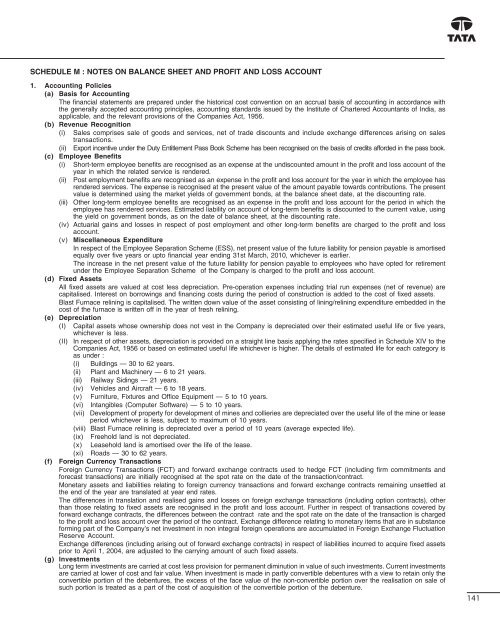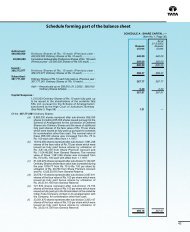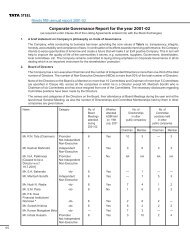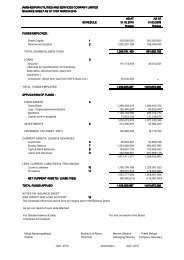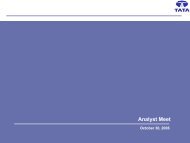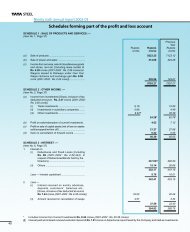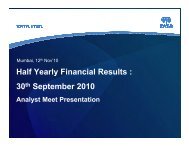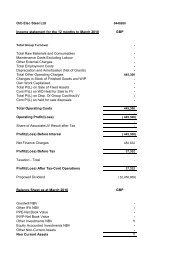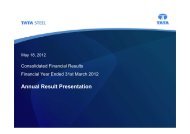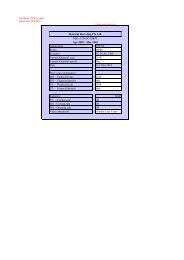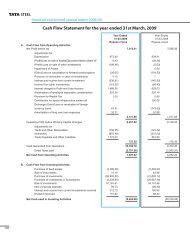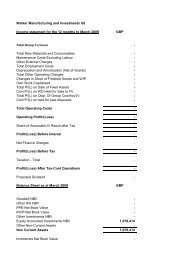100th Annual Report 2006-2007 - Tata Steel
100th Annual Report 2006-2007 - Tata Steel
100th Annual Report 2006-2007 - Tata Steel
You also want an ePaper? Increase the reach of your titles
YUMPU automatically turns print PDFs into web optimized ePapers that Google loves.
SCHEDULE M : NOTES ON BALANCE SHEET AND PROFIT AND LOSS ACCOUNT<br />
1. Accounting Policies<br />
(a) Basis for Accounting<br />
The financial statements are prepared under the historical cost convention on an accrual basis of accounting in accordance with<br />
the generally accepted accounting principles, accounting standards issued by the Institute of Chartered Accountants of India, as<br />
applicable, and the relevant provisions of the Companies Act, 1956.<br />
(b) Revenue Recognition<br />
(i) Sales comprises sale of goods and services, net of trade discounts and include exchange differences arising on sales<br />
transactions.<br />
(ii) Export incentive under the Duty Entitlement Pass Book Scheme has been recognised on the basis of credits afforded in the pass book.<br />
(c) Employee Benefits<br />
(i) Short-term employee benefits are recognised as an expense at the undiscounted amount in the profit and loss account of the<br />
year in which the related service is rendered.<br />
(ii) Post employment benefits are recognised as an expense in the profit and loss account for the year in which the employee has<br />
rendered services. The expense is recognised at the present value of the amount payable towards contributions. The present<br />
value is determined using the market yields of government bonds, at the balance sheet date, at the discounting rate.<br />
(iii) Other long-term employee benefits are recognised as an expense in the profit and loss account for the period in which the<br />
employee has rendered services. Estimated liability on account of long-term benefits is discounted to the current value, using<br />
the yield on government bonds, as on the date of balance sheet, at the discounting rate.<br />
(iv) Actuarial gains and losses in respect of post employment and other long-term benefits are charged to the profit and loss<br />
account.<br />
(v) Miscellaneous Expenditure<br />
In respect of the Employee Separation Scheme (ESS), net present value of the future liability for pension payable is amortised<br />
equally over five years or upto financial year ending 31st March, 2010, whichever is earlier.<br />
The increase in the net present value of the future liability for pension payable to employees who have opted for retirement<br />
under the Employee Separation Scheme of the Company is charged to the profit and loss account.<br />
(d) Fixed Assets<br />
All fixed assets are valued at cost less depreciation. Pre-operation expenses including trial run expenses (net of revenue) are<br />
capitalised. Interest on borrowings and financing costs during the period of construction is added to the cost of fixed assets.<br />
Blast Furnace relining is capitalised. The written down value of the asset consisting of lining/relining expenditure embedded in the<br />
cost of the furnace is written off in the year of fresh relining.<br />
(e) Depreciation<br />
(I) Capital assets whose ownership does not vest in the Company is depreciated over their estimated useful life or five years,<br />
whichever is less.<br />
(II) In respect of other assets, depreciation is provided on a straight line basis applying the rates specified in Schedule XIV to the<br />
Companies Act, 1956 or based on estimated useful life whichever is higher. The details of estimated life for each category is<br />
as under :<br />
(i) Buildings — 30 to 62 years.<br />
(ii) Plant and Machinery — 6 to 21 years.<br />
(iii) Railway Sidings — 21 years.<br />
(iv) Vehicles and Aircraft — 6 to 18 years.<br />
(v) Furniture, Fixtures and Office Equipment — 5 to 10 years.<br />
(vi) Intangibles (Computer Software) — 5 to 10 years.<br />
(vii) Development of property for development of mines and collieries are depreciated over the useful life of the mine or lease<br />
period whichever is less, subject to maximum of 10 years.<br />
(viii) Blast Furnace relining is depreciated over a period of 10 years (average expected life).<br />
(ix) Freehold land is not depreciated.<br />
(x) Leasehold land is amortised over the life of the lease.<br />
(xi) Roads — 30 to 62 years.<br />
(f) Foreign Currency Transactions<br />
Foreign Currency Transactions (FCT) and forward exchange contracts used to hedge FCT (including firm commitments and<br />
forecast transactions) are initially recognised at the spot rate on the date of the transaction/contract.<br />
Monetary assets and liabilities relating to foreign currency transactions and forward exchange contracts remaining unsettled at<br />
the end of the year are translated at year end rates.<br />
The differences in translation and realised gains and losses on foreign exchange transactions (including option contracts), other<br />
than those relating to fixed assets are recognised in the profit and loss account. Further in respect of transactions covered by<br />
forward exchange contracts, the differences between the contract rate and the spot rate on the date of the transaction is charged<br />
to the profit and loss account over the period of the contract. Exchange difference relating to monetary items that are in substance<br />
forming part of the Company’s net investment in non integral foreign operations are accumulated in Foreign Exchange Fluctuation<br />
Reserve Account.<br />
Exchange differences (including arising out of forward exchange contracts) in respect of liabilities incurred to acquire fixed assets<br />
prior to April 1, 2004, are adjusted to the carrying amount of such fixed assets.<br />
(g) Investments<br />
Long term investments are carried at cost less provision for permanent diminution in value of such investments. Current investments<br />
are carried at lower of cost and fair value. When investment is made in partly convertible debentures with a view to retain only the<br />
convertible portion of the debentures, the excess of the face value of the non-convertible portion over the realisation on sale of<br />
such portion is treated as a part of the cost of acquisition of the convertible portion of the debenture.<br />
141


